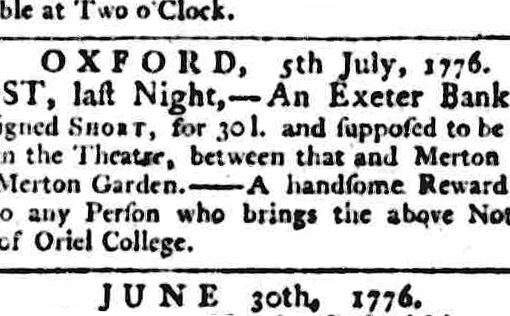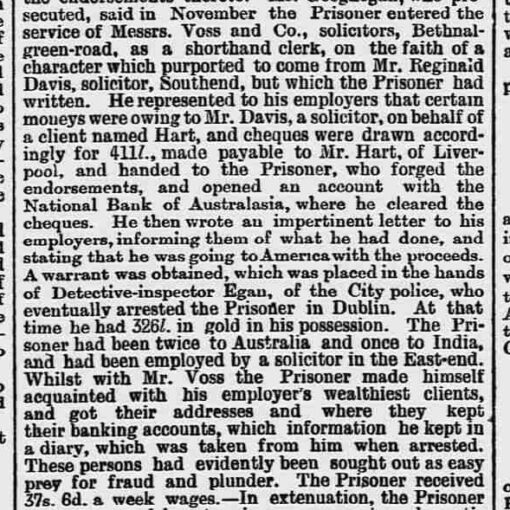Sheffield Independent, Monday, 5 January 1874:

Critical Condition of a Drunken Man
About eight o’clock on Saturday evening, Police-constable Stone found a man named William Keddy of Arthur Street lying in Bridge Street. He was drunk and bleeding profusely from a wound on the back of his head. The officer removed him to the Police Offices, where he was seen by Mr. Hallam, surgeon to the police force. Under his direction, the man was removed to the Public Hospital. He is supposed to have received his injuries from falling.
Housebreaking in Clarkhouse Lane
There has been another illustration of the risks householders run by leaving their houses unattended. Some time between two and nine on Thursday afternoon, the house of Mr. William Parkin, Clarkhouse Lane, was entered during the absence of the family. The back kitchen window was forced open, and an entrance was effected. The house appeared to have been thoroughly ransacked. A silver ornament, a necklace, and some other articles of jewellery were taken. Money was evidently what the thieves were after, but they were disappointed with their booty.
The Colliery Disputes Near Barnsley
The dispute at the Monk Bretton Colliery, where men sent in their notices against the wishes of the South Yorkshire Miners’ Association, has been resolved by the masters granting an advance of 3d. per ton on some parts of strait work and 6d. per ton on others. The miners belonging to the Havercroft Lodge of the South Yorkshire Miners’ Association are still out and receiving no support from the union, which has denounced their conduct.
Doncaster West Riding Petty Sessions
At this court on Saturday, a serious case of assault, or rather a series of cases, was heard. Two men, named Richard Guest and Hermit Guest, both watermen of Mexborough, were brought up for assaulting Arthur Burland, a boat hauler, of the same place, on Friday, the 26th ult. Another case involved George Thompson, waterman of Denaby, who was accused of assaulting Thomas Thompson, labourer of Rotherham, at the same time and place. Finally, Richard Guest was charged with assaulting Henry Lee, fireman of Denaby, during the same disturbance. Lee, it appeared, was so injured that his advocate, Mr. Hall, said he was seriously ill, and it was impossible to say how the case might turn out. This summons was accordingly adjourned for a week.
It appeared that on the 26th ult. all the men were at the Ferry Boat Inn, Mexborough. A dispute arose, and Henry Guest told Lee he would “get it” before leaving. When Lee reached the steps outside, Richard Guest knocked him down, causing Lee to bleed profusely. Medical evidence showed he was seriously injured. In addition, other assaults followed in the same altercation. The Bench fined the Guests 20s. each, with 17s. costs each. George Thompson was also fined 20s. and 17s. 6d. costs. No evidence supported claims that Lee’s party started the quarrel.
Analysis and Context of Life in the 1870s in the UK:
- Alcohol and Public Order: The case of William Keddy reflects the common issues of alcohol abuse and the vulnerability it created. Drunkenness in public spaces was a frequent issue, often leading to injuries, arrests, or medical intervention.
- Crime and Security: The housebreaking incident highlights the risks of burglary in a society where households often lacked modern security measures. The report underscores the prevalence of property crime during a time of economic disparity and growing urbanisation.
- Labour Disputes: The Monk Bretton Colliery dispute illustrates the tensions between workers, unions, and employers during the Industrial Revolution. Strikes and pay disputes were widespread, with miners and other workers pushing for fairer wages and better working conditions.
- Judicial and Social Order: The Doncaster petty sessions reveal how local courts dealt with violence and public disturbances. The emphasis on fines and legal representation indicates a structured but often reactive approach to maintaining social order.
- Community Dynamics: The articles reflect a close-knit society where personal disputes could escalate into legal cases and involve multiple members of the community, as seen in the detailed accounts of the brawls.
1. Alcohol and Public Order
- Insight: William Keddy’s situation reflects the lack of public health and social support systems for those struggling with alcohol. Drunkenness was common in working-class communities, often tied to the hardships of industrial and urban life.
- Context: Pubs and inns were central to social life but also hotspots for disorder. Alcohol provided an escape from the struggles of low wages, poor living conditions, and gruelling work. However, excessive drinking led to frequent injuries, public nuisances, and arrests.
- Broader Implications: The absence of social safety nets or organised public health interventions meant cases like Keddy’s relied on police and surgeons, whose resources were limited.
2. Crime and Security
- Insight: The burglary in Clarkhouse Lane underscores the vulnerability of homes to theft. Burglars often targeted unoccupied homes, and valuables like jewellery and cash were prime targets.
- Context: The lack of advanced locking mechanisms and community policing meant householders had to rely on vigilance and luck. Crime was often driven by economic desperation or the allure of quick profits in an era of growing inequality.
- Broader Implications: This era saw increasing pressure for police reform and professionalisation. By the 1870s, the Metropolitan Police model was spreading to provincial towns, aiming to curb crime and maintain order.
3. Labour Disputes and Worker Struggles
- Insight: The Monk Bretton Colliery dispute reflects the fraught relationship between labour and management. Workers sought fair pay and conditions, often against the wishes of their unions, highlighting divisions within the labour movement.
- Context: The 1870s were a period of significant industrial unrest. The trade union movement was growing, but unions often faced challenges from workers who acted independently when dissatisfied with union strategies. The advances of 3d and 6d per ton indicate how critical even small wage increases were to miners.
- Broader Implications: These disputes laid the groundwork for later legislation supporting workers’ rights, including the Employers and Workmen Act of 1875, which sought to balance power between employers and workers.
4. The Judicial System
- Insight: The Doncaster West Riding Petty Sessions case reveals the focus on fines as punishment and the role of medical evidence in legal proceedings. The heavy fines for assault were a financial burden for working-class individuals but were intended to deter future violence.
- Context: Local courts dealt with a mix of minor and serious offences, often serving as the first point of legal recourse. The detailed description of the fight and its aftermath suggests that such cases were common and drew significant public interest.
- Broader Implications: The legal system reflected class dynamics. Wealthier individuals could afford legal representation and fines more easily, while the working class often faced harsher consequences, deepening societal divides.
5. Community and Social Tensions
- Insight: The detailed accounts of personal disputes escalating into violence, as seen in the Mexborough brawl, highlight the tensions in close-knit communities. The role of alcohol, personal grudges, and local rivalries often led to violent confrontations.
- Context: Industrial towns like Mexborough saw rapid population growth, bringing together people from different regions and backgrounds. This often led to frictions, especially in pub settings where alcohol fuelled disagreements.
- Broader Implications: Such incidents underline the need for local law enforcement and community mediators to prevent minor disputes from escalating. It also reflects the limited recreational options for the working class, with pubs serving as both social hubs and sites of conflict.
The Bigger Picture of the 1870s in the UK
- Industrialisation: Britain was at the height of its industrial revolution. Urbanisation brought both opportunities and challenges, such as overcrowding, poor sanitation, and rising crime rates.
- Social Reform: Movements for education, workers’ rights, and public health were gaining momentum. However, progress was slow and often met with resistance from established power structures.
- Technology and Innovation: Advances in printing and communications allowed newspapers like the Sheffield Independent to document local and national issues in detail, fostering public awareness and debate.
- Class Divisions: Society was deeply stratified. The working class bore the brunt of industrial and urban hardships, while the middle and upper classes were better positioned to benefit from economic growth.
- Legal and Policing Reforms: Efforts to professionalise the police and streamline the legal system were ongoing. The petty sessions illustrate the evolving judicial processes in local courts.
The Sheffield Independent

The Sheffield Independent: A Journey Through History
First published in December 1819, The Sheffield Independent was founded by Henry Andrew Bacon. However, the venture soon required additional financial support. In December 1820, Thomas Asline Ward and Michael Ellison joined as partners, providing the necessary capital. In 1829, the newspaper was purchased by Robert Leader (1779–1861), who upheld its original Liberal political and commercial principles. Ownership later passed to his son, Robert Leader (1809–1885), who served as both editor and chief writer from 1833 until 1875. An accomplished shorthand writer and skilled reporter on local events, he played a key role in elevating the paper’s reputation.
In January 1860, his sons, John Daniel Leader (b. 1835) and Robert Eadon Leader (b. 1839), joined the business as partners. Later, in January 1887, John Daniel’s son, Robert (b. 1860), also became part of the family-run enterprise, continuing its legacy.
The Liberal Government’s reduction of stamp duty in 1836, from 4d to 1d, led to a landmark decision by nine Yorkshire newspaper proprietors to lower their publication prices. The Sheffield Independent first adopted its reduced price of 4½d on 17 September 1836. Further changes followed the removal of the penny stamp duty in 1855, when the price dropped to 3½d, and by October 1861, the paper was being sold daily for just 1d. These reductions significantly boosted circulation, with weekly sales rising from 1,272 in 1838 to 2,596 by 1842, reaching 12,525 by 1857 and an impressive 35,000 by 1882.
Technological progress accompanied this growth in readership. By 1858, the paper utilised two Cowper printing machines, each capable of producing 2,000 copies per hour. A paper-folding machine was later introduced to streamline production. By 1881, three Victory printing machines had been installed, enabling the production of up to 52,000 copies per hour. The introduction of stereotyping in the early 1870s further modernised operations, reducing both time and costs associated with font renewal.
As the newspaper expanded, it relocated six times within Sheffield between 1819 and 1892. That year, operations moved to a purpose-built facility at 21 Fargate, equipped with modern editorial and production technologies that marked a new era in mass circulation publishing.
In 1938, The Sheffield Independent merged with the Sheffield Telegraph, bringing an end to its independent publication. The merger closed a significant chapter in the history of regional journalism in Britain, but its legacy as a pioneering force in the newspaper industry endures.
Crime, Conflict, and Colliery Disputes: Life in Sheffield and Doncaster – 1874.
#VictorianEra #SheffieldHistory #Doncaster #CrimeAndJustice #IndustrialRevolution #HistoricalNews




